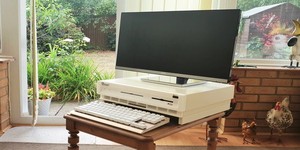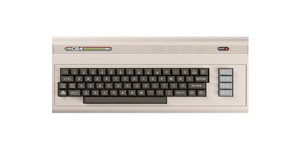
Today marks the 30th anniversary of the Commodore 64, a computer which launched the careers of many coders and hackers and which remains to this day the single best-selling model of computer in history.
Released in 1982 in the US at a price of $595 (around £379.68 excluding taxes, or a whopping £1,146.63 when corrected for inflation) the Commodore 64 took the world by storm. Total lifetime sales are generally believed to have been between 12.5 million and 17 million units world-wide, with the Commodore 64 easily outselling rivals including those from the up-and-coming Apple. The system was so successful, in fact, it would continue to be manufactured and sold until 1994 - the equivalent to Intel being able to sell systems based on a Pentium III 866MHz chip today.
The C64 was the brainchild of Commodore founder Jack Tramiel, an immigrant to the US who worked his way up from taxi driver to owner of a typewriter repair company, giving up typewriters for a successful line of calculators when the digital revolution was truly underway and then moving sideways into microcomputers following the flood of cheap Chinese devices into the calculator market. Early systems, including the MOS KIM-1 and the Commodore PET, had inspired Steve Wozniak to build his Apple Computer from the 6502 processor created by Commodore subsidiary MOS Technology - with MOS staff actually helping Wozniak design the system, a fact frequently forgotten by fans of Apple's supposedly self-contained innovation.
The Commodore 64 was Tramiel's answer to the demand for more capabilities. Based on a MOS Technologies 6510 processor running at just under 1MHz in PAL regions and just over in NTSC regions, the C64 included - as the name suggests - 64KB of RAM and a 20KB ROM containing a modified copy of Microsoft BASIC as the operating system and chief programming language. Microsoft, for its part, received no royalties on Commodore sales, having sold the rights to BASIC for a fixed sum years prior.
The processor and memory weren't the key features of the C64, however. A graphics chip, the VIC-II, provided a 320x200 resolution display with 16 colours, in-built sprite handling and collision detection and a raster interrupt system - all evidence of the VIC's origins as a chip designed for use in arcade machines. These impressive graphics capabilities - for the era - were joined by the SID 6581 sound chip, capable of three-voice synthesis with full user control. Bugs in the original SID 6581 would allow coders to sneak in a fourth voice and play back sampled audio - a feature which, combined with the chip's distinctive sound, makes the SID 6581 a popular choice today for electronic musicians.
Not everything about the C64 was great, however. The version of BASIC purchased from Microsoft was sorely outdated, but used nearly unmodified at Tramiel's insistence in order to save on licensing costs. Another cost-saving measure in the original production run was to use the same case design as the preceding VIC-20, meaning shortcuts had to be taken in the printed circuit board layout - shortcuts which led directly to the C64's famously slow serial port and painful tape loading mechanism.
The pros outweighed the cons, however, and the C64 dominated the early home computing revolution. Its popularity continued well past the launch of Commodore's 16-bit successor, the Amiga, with the company producing upwards of 400,000 models a month. Later, the 64C - a revised C64 design in an Amiga-style casing - would drive down costs and increase reliability, while the C128 and disk drive equipped C128D provided double the memory, a numeric keypad and an upgraded copy of BASIC, along with a Z80 co-processor which was capable of running the business-oriented CP/M operating system in 40 or 80 column mode.
Few of Commodore's eight-bit spin-offs would enjoy the same success of the C64, sadly - with the luggable SX64 and keyboardless 64GS console particularly sought-after now as rarities thanks to poor sales - and Tramiel's exit from the company and subsequent purchase of the Atari brand would lead to bitter rivalry in the 16-bit era. These days, Commodore is no more - although Commodore USA produces modern PCs designed along the same lines as the C64, having licensed the rights to the name.
That's not to say the C64 isn't still popular, however: the company may have long since vanished, but the system remains much-loved. Synthesised sounds from a C64's SID chip can still be heard in the background of songs from big-name acts - albeit sometimes in an uncredited form - while hackers like Jeri Ellsworth have taken the original C64 design and recreated it for the modern era, along with some less commercially viable projects.
Meanwhile, if you want to remember what life was like before Windows, OS X and memory measured in megabytes, Commodore 64s remain readily available second-hand - or you could just fire up one of the many emulators.
Released in 1982 in the US at a price of $595 (around £379.68 excluding taxes, or a whopping £1,146.63 when corrected for inflation) the Commodore 64 took the world by storm. Total lifetime sales are generally believed to have been between 12.5 million and 17 million units world-wide, with the Commodore 64 easily outselling rivals including those from the up-and-coming Apple. The system was so successful, in fact, it would continue to be manufactured and sold until 1994 - the equivalent to Intel being able to sell systems based on a Pentium III 866MHz chip today.
The C64 was the brainchild of Commodore founder Jack Tramiel, an immigrant to the US who worked his way up from taxi driver to owner of a typewriter repair company, giving up typewriters for a successful line of calculators when the digital revolution was truly underway and then moving sideways into microcomputers following the flood of cheap Chinese devices into the calculator market. Early systems, including the MOS KIM-1 and the Commodore PET, had inspired Steve Wozniak to build his Apple Computer from the 6502 processor created by Commodore subsidiary MOS Technology - with MOS staff actually helping Wozniak design the system, a fact frequently forgotten by fans of Apple's supposedly self-contained innovation.
The Commodore 64 was Tramiel's answer to the demand for more capabilities. Based on a MOS Technologies 6510 processor running at just under 1MHz in PAL regions and just over in NTSC regions, the C64 included - as the name suggests - 64KB of RAM and a 20KB ROM containing a modified copy of Microsoft BASIC as the operating system and chief programming language. Microsoft, for its part, received no royalties on Commodore sales, having sold the rights to BASIC for a fixed sum years prior.
The processor and memory weren't the key features of the C64, however. A graphics chip, the VIC-II, provided a 320x200 resolution display with 16 colours, in-built sprite handling and collision detection and a raster interrupt system - all evidence of the VIC's origins as a chip designed for use in arcade machines. These impressive graphics capabilities - for the era - were joined by the SID 6581 sound chip, capable of three-voice synthesis with full user control. Bugs in the original SID 6581 would allow coders to sneak in a fourth voice and play back sampled audio - a feature which, combined with the chip's distinctive sound, makes the SID 6581 a popular choice today for electronic musicians.
Not everything about the C64 was great, however. The version of BASIC purchased from Microsoft was sorely outdated, but used nearly unmodified at Tramiel's insistence in order to save on licensing costs. Another cost-saving measure in the original production run was to use the same case design as the preceding VIC-20, meaning shortcuts had to be taken in the printed circuit board layout - shortcuts which led directly to the C64's famously slow serial port and painful tape loading mechanism.
The pros outweighed the cons, however, and the C64 dominated the early home computing revolution. Its popularity continued well past the launch of Commodore's 16-bit successor, the Amiga, with the company producing upwards of 400,000 models a month. Later, the 64C - a revised C64 design in an Amiga-style casing - would drive down costs and increase reliability, while the C128 and disk drive equipped C128D provided double the memory, a numeric keypad and an upgraded copy of BASIC, along with a Z80 co-processor which was capable of running the business-oriented CP/M operating system in 40 or 80 column mode.
Few of Commodore's eight-bit spin-offs would enjoy the same success of the C64, sadly - with the luggable SX64 and keyboardless 64GS console particularly sought-after now as rarities thanks to poor sales - and Tramiel's exit from the company and subsequent purchase of the Atari brand would lead to bitter rivalry in the 16-bit era. These days, Commodore is no more - although Commodore USA produces modern PCs designed along the same lines as the C64, having licensed the rights to the name.
That's not to say the C64 isn't still popular, however: the company may have long since vanished, but the system remains much-loved. Synthesised sounds from a C64's SID chip can still be heard in the background of songs from big-name acts - albeit sometimes in an uncredited form - while hackers like Jeri Ellsworth have taken the original C64 design and recreated it for the modern era, along with some less commercially viable projects.
Meanwhile, if you want to remember what life was like before Windows, OS X and memory measured in megabytes, Commodore 64s remain readily available second-hand - or you could just fire up one of the many emulators.

MSI MPG Velox 100R Chassis Review
October 14 2021 | 15:04








Want to comment? Please log in.